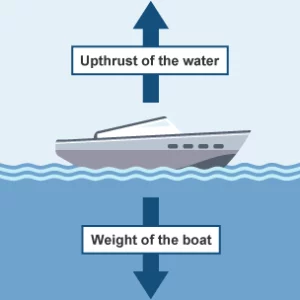Physical Address
UPTHRUST AND DENSITY JS3 E-NOT
By the end of the lesion the students should be able to

Explain the term Up Thrust and Density.
State the Archimedes Principle and Law of Flotation,
Establish the Different Between Up Thrust and Density
EXPLANATION IN DETAILS:
“Upthrust” is a term commonly used in physics, specifically in the context of fluid mechanics or buoyancy. It refers to the upward force exerted by a fluid on an object placed in it or submerged in it. This force is a result of the pressure difference between the top and bottom of the object.
UPTHRUST AND DENSITY JS3 E-NOT
When an object is placed in a fluid (liquid or gas), it displaces some of the fluid. The fluid exerts pressure on the object from all directions. However, the pressure increases with depth due to the weight of the fluid above it. This results in a higher pressure at the bottom of the object compared to the top. The pressure difference between the top and bottom creates an upward force, known as upthrust or buoyant force.
Density, on the other hand, is a measure of how much mass is contained in a given volume of a substance. It is usually expressed in units such as kilograms per cubic meter (kg/m³) or grams per cubic centimeter (g/cm³).
The relationship between upthrust and density is fundamental to understanding buoyancy. Archimedes’ principle states that the buoyant force acting on an object submerged in a fluid is equal to the weight of the fluid displaced by the object. This buoyant force depends on the density of the fluid and the volume of the displaced fluid.
The density of an object also plays a crucial role. If the object’s density is greater than that of the fluid, it will sink as the upthrust will be less than its weight. If the object’s density is less than that of the fluid, it will float as the upthrust will exceed its weight. And if the object’s density is equal to that of the fluid, it will remain suspended at a certain level within the fluid.
So, in summary, upthrust is the upward force exerted by a fluid on an object, and density is a measure of how tightly packed the mass within a substance is. The interplay between these two concepts explains why objects sink or float in fluids.
What Is Up Thrust
Upthrust: Upthrust, also known as buoyant force, is the upward force exerted by a fluid (liquid or gas) on an object placed in it or submerged in it. It occurs due to the pressure difference between the top and bottom of the object within the fluid.
What Is Density
Density: Density is a measure of how much mass is contained in a given volume of a substance. It is usually expressed in units such as kilograms per cubic meter (kg/m³) or grams per cubic centimeter (g/cm³).
STATE THE ARCHIMEDES PRINCIPLE AND LAW OF FLOTATION:
ARCHIMEDES’ PRINCIPLE:
Archimedes’ principle states that the buoyant force acting on an object submerged in a fluid is equal to the weight of the fluid displaced by the object. In simpler terms, the buoyant force experienced by an object in a fluid is equal to the weight of the fluid that the object displaces.
LAW OF FLOTATION:
The law of flotation states that a floating object displaces its own weight of the fluid in which it floats. In other words, the weight of the fluid displaced by the floating object is equal to the weight of the object itself.
DIFFERENT BETWEEN UP THRUST AND DENSITY
Definition: Upthrust is a force exerted by a fluid on an object immersed in it, whereas density is a property of matter, describing how much mass is packed into a given volume.
Nature: Upthrust is a force, while density is a property.
Cause: Upthrust is caused by the pressure difference within a fluid, while density is an intrinsic property of a substance.
Measurement: Upthrust is measured in force units (such as Newtons), while density is measured in mass per unit volume (such as kg/m³ or g/cm³).
In summary, upthrust is the force exerted by a fluid on an object, while density is a property of the object itself. The relationship between these two concepts explains why objects sink or float in fluids, as described by Archimedes’ principle and the law of flotation.
